Climate Policy: Responsibilities and Liabilities
“He who has the benefit must also bear the damage,” is how Walter Eucken summed up the principle of liability, a cornerstone of functioning market economies. This also applies to climate policy. From an ordoliberal point of view, it is not acceptable to make profits while socializing environmental damage. In the run-up to the UN Climate Change Conference in Glasgow, we are calling for a more consistent assumption of responsibility in a focus paper. The industrialized countries are primarily liable, even if the reduction of CO2 emissions and the protection of forest areas demand concerted international efforts.
Responsibilities for climate change
For decades, industrialized countries in the North (East and West) have been able to build their prosperity and growth on cheap and climate-hostile energy combustion. Environmental damage and climate change, on the other hand, are now having a particularly damaging effect on the global South. The historical responsibility of the developed economies of Europe and North America, and secondarily, of some of the emerging economies in Asia, becomes clear when cumulative CO2 emissions are considered. Europe alone is responsible for just under 32 percent of these emissions. By contrast, Africa and South America together only account for around five percent (see Figure 1).
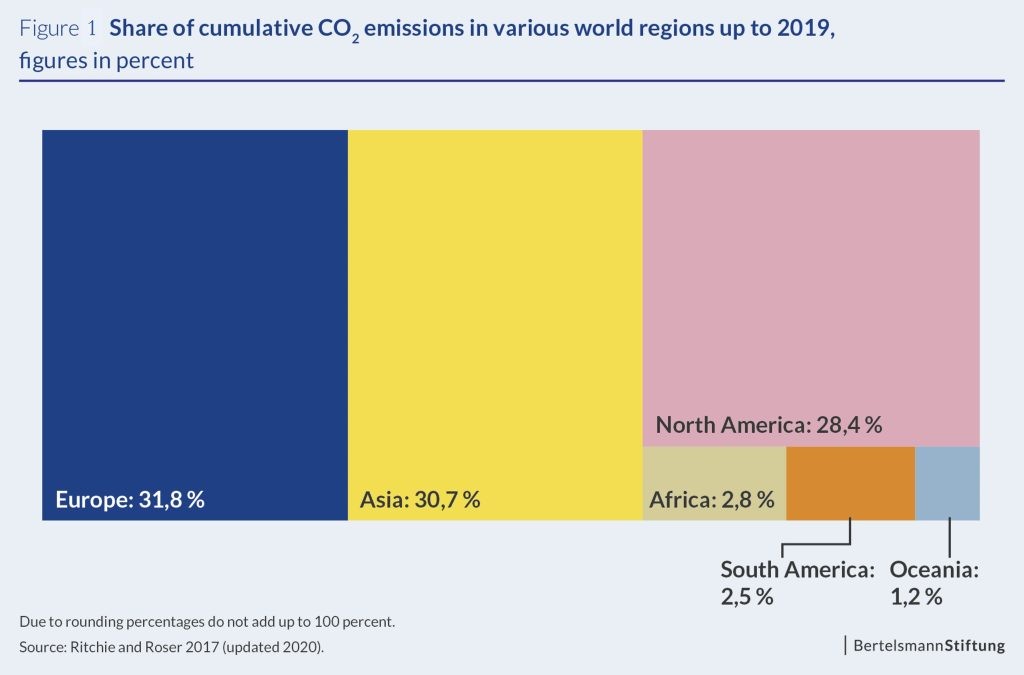
The same applies with regard to the current responsibility for excessively high global CO2 emissions. With a total of almost 1.4 billion inhabitants, the 38 OECD countries have a population similar in size to that of China and India respectively. But while in 2019, according to the EU Commission, the OECD’s share of annual global CO2 emissions was about 32 percent and China’s was just over 30 percent, India’s share was just under 7 percent. This in itself points to very different current responsibilities. They become even clearer in contrast with the 42 least polluting developing countries, also with 1.4 billion inhabitants, which are responsible for just 1.27 percent of global CO2 emissions (dark green on the world map).
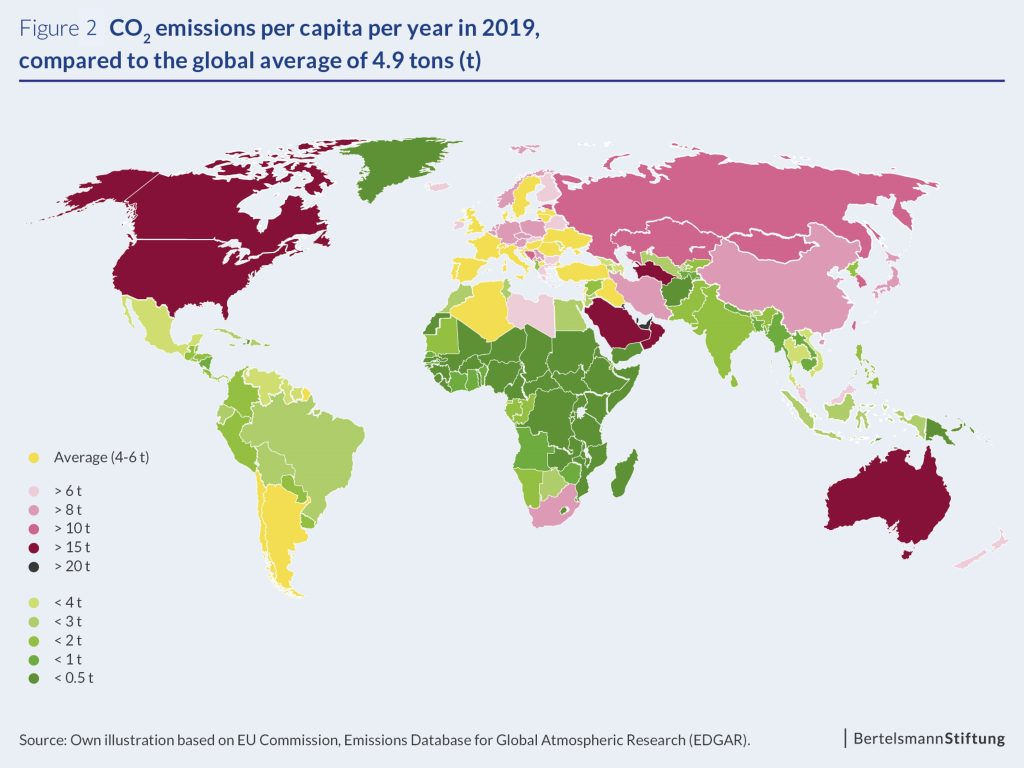
As Figure 2 shows, annual per capita CO2 emissions are below the global average of 4.9 metric tons in well over 100 countries, while more than 50 countries are above it, in some cases significantly so. Currently, the most polluting countries are the Gulf States, followed by Australia, the USA and Canada. Most of the less developed economies have much lower per capita greenhouse gas emissions. The share of emerging and developing countries outside Asia in global emissions is small.
From the perspective of the liability principle, it follows: If the developed industrialized countries owe their economic prosperity to a resource-intensive and climate-hostile mode of production pursued over many decades and are thus responsible for the majority of the greenhouse gases emitted to date and the resulting damage, they must pay for the redress of this damage in the sense of historical liability. If, moreover, these historically privileged countries – mostly states with also currently very high CO2 emissions per capita – demand that most developing countries that currently still produce relatively low levels of pollutants renunciate their future resource-driven growth, then they must not only compensate for this renunciation proportionally, but are above all obliged to significantly reduce their own pollutant emissions in the sense of a current liability. In terms of fiduciary liability for forest protection, national sovereigns of global public goods have a political and operational responsibility. But in connection with their historical responsibility, it is once again essentially the developed industrialized countries that must be held financially accountable to limit the consequences of their cumulative CO2 emissions to date.
Instruments of international climate policy
In general, a primary liability of the industrialized countries has been established since the Rio Conference of 1992 in the understanding of “common but differentiated responsibilities” and in the UN Framework Convention on Climate Change (UNFCCC) adopted there and confirmed in the Kyoto Protocol and the Paris Agreement. For implementation, the governments of the industrialized countries have a number of funds at their disposal, which were established within the framework of the UNFCCC or set up by multilateral organizations. The Green Climate Fund (GCF) certainly deserves special mention. It is currently the largest multilateral climate fund and the central financing mechanism to help developing countries reduce their greenhouse gas emissions and improve their adaptive capacity to climate change. The allocation of its funding of a targeted $10 billion per year starting in 2020 is intended to be balanced between pollution reduction and climate adaptation. The Climate Funds Update by the Heinrich Böll Foundation and Overseas Development Institute provides a detailed overview of the wide range of climate change-related financing institutions.
Market mechanisms such as carbon pricing are prominently discussed for emissions reduction. Their approach to internalizing negative externalities follows the liability principle, according to which economic actors must bear all costs of their actions. If market prices do not include these costs, the state must intervene and ensure that emissions are priced. Their amount is based on the damage caused by a ton of CO2, expressed in monetary units. The higher the carbon pricing, the more stringent this instrument becomes. There is clearly room for improvement here.
Conversely, the more emissions-intensive economic activities are shifted to countries with less stringent climate policies, the blunter the instrument becomes. This carbon leakage can be countered with the help of a so-called Carbon Border Adjustment Mechanism. It imposes a CO2 duty on products imported from abroad that is equivalent to the domestic CO2 price and exempts exports by domestic companies from the applicable CO2 price. This removes the incentive to relocate emissions-intensive activities to countries with a lower emissions price. In this context, we also address the creation of a climate club suggested by economist William Nordhaus, which would strengthen the effectiveness of carbon pricing through concerted action by countries that agree on a uniform CO2 price.
However, the development policy dimension must also be considered here. Excessive burdens on least developed countries brought on by a climate action that may be taken primarily in industrialized countries is not compatible with the principle of liability outlined here, nor with the idea of shared but differentiated responsibilities. Therefore, in our focus paper, we discuss exempting them from the emissions levy. Finally, we also discuss the possibility of cost-effective, emissions-reducing investments in developing countries through the use of the Clean Development Mechanism, which allows emitters in industrialized countries that make climate-protective investments in developing countries to purchase carbon credits.
Limited willingness to assume liability
So many declarations of intent, so many available instruments – and at the same time so little political will to actually meet the liability obligation that has long been formally recognized. Neither is it to be denied that some industrialized nations such as the USA and Germany have substantially reduced their carbon dioxide emissions over the last ten years, nor that significant funds are being raised by OECD countries for climate protection. Measured against the level of their current CO2 emissions and their historical responsibility, however, this is far too little.
The Climate Action Tracker paints a bleak picture. It identifies the climate policies and targets of all major emitters (accounting for about 80 percent of global emissions and about 70 percent of the world’s population) and assesses their adequacy to achieve the 1.5°C target set in the Paris Agreement. Result: almost all OECD countries fall short of stated targets. Measured solely in terms of domestic reduction targets, among the 15 OECD countries examined in the Climate Action Tracker, only the United Kingdom achieves compatibility with the 1.5°C target.
The U.S. is by far the largest emitter in the OECD, accounting for 4.3 percent of the world’s population and at the same time 13.4 percent of global CO2 emissions. It is unclear whether it can regain its climate policy credibility under President Biden, as the current Senate majorities for setting climate targets are very fragile. Prospects are better for the European Green Deal, under which EU member states aim for climate neutrality by 2050 and a 55 percent emissions reduction target by 2030 compared to 1990 levels. However, to meet the Paris Agreement targets, the EU would have to increase its near-term reduction target to 63 percent, achieve a comprehensive coal phase-out, and invest more in climate finance.
This last point is crucial. Many governments of OECD countries are unwilling to meet the payment commitments they have made in terms of historical liability, or even to extend them. To date, developed countries have contributed one-fifth less to climate finance than previously pledged, creating a large funding gap. In particular, climate financing by Australia, Japan, and the U.S. shows large deficits because it includes large fossil fuel investments in other countries in addition to too little willingness to pay.
In general, many OECD countries take their national reduction targets, and thus their current liability, much more seriously than climate financing, and thus their historical liability. Combining these two aspects of liability, most OECD countries are rated “insufficient” by the Climate Action Tracker. That is, their climate policies – if they were global in scale – would contribute to global warming of 2 to 3°C.
The current funding gap in global climate action not only represents a pronounced irresponsibility on the part of industrialized countries with regard to their accepted historical liability, it also sends a devastating signal with regard to the UN Climate Change Conference. In the long term, this denial of liability will backfire on the OECD countries for two reasons: it will make negotiations with other major emitters such as China, India and Russia much more difficult, and it will undermine their credibility in relation to poorer developing countries, whose CO2 emissions have only grown in recent years, but at a rapid pace.
Almost all emerging economies are rated as “highly insufficient” in their climate policies by the Climate Action Tracker. Goals of catch-up growth, protection of the domestic energy industry, and patronage-based political pressure are keeping many governments from setting more ambitious climate targets. Among the eleven largest emitters in the BTI sample of 137 developing and emerging economies – including the OECD countries of Mexico, South Korea and Turkey – there is no country other than Iran that is not also a member of the G20. Together, these eleven countries emitted 53.64 percent of global CO2 emissions in 2019, according to the EU Commission (see Figure 3).
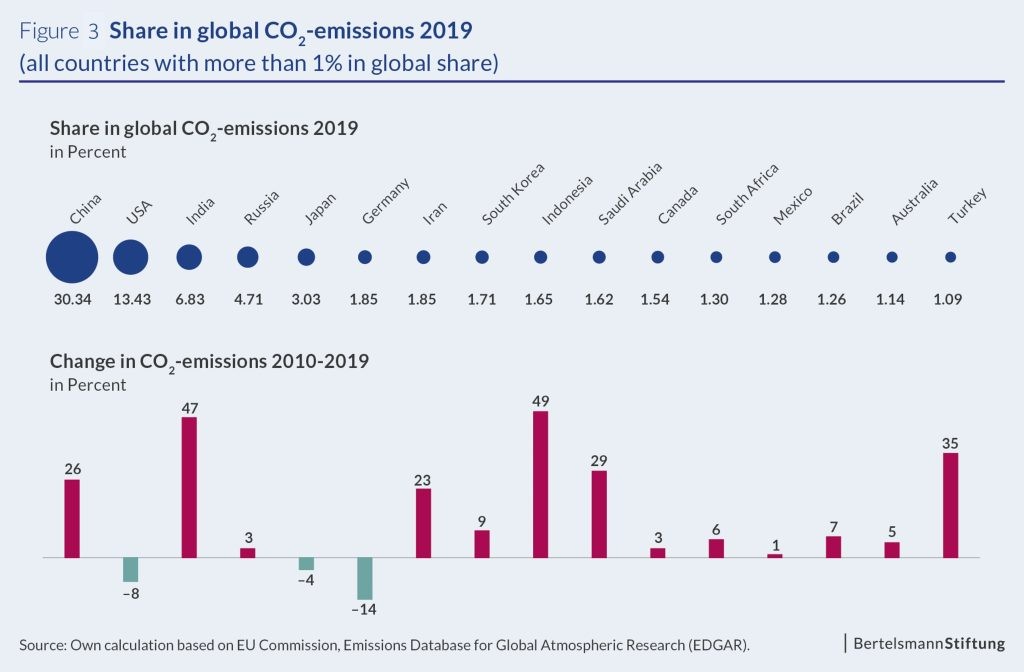
China, which alone is currently responsible for over 30 percent of global CO2 emissions, plays a particularly important role. Like Russia, China has announced its intention to achieve climate neutrality by 2060. The Chinese targets may be ambitious and, according to calculations by Chinese ministries, will entail annual investments of up to US $490 billion by 2060, but they are not sufficient. For one thing, according to calculations by the Intergovernmental Panel on Climate Change in 2018, economies must have achieved climate neutrality as early as 2050 in order to still meet the target of global warming of just 1.5°C. On the other hand, the Chinese government’s new five-year plan presented in 2021 includes a massive expansion of coal-fired power generation. At least, however, the Chinese government has announced that it will end its extensive relocation of pollutant-intensive coal-fired power generation with outdated power plant technology abroad. China is showing a willingness to reform, but will have to move further and to a significant extent. It understandably will not do so alone, but only in concert with Western industrialized nations.
India cannot follow the Chinese path without triggering a global climate catastrophe and will need substantial assistance in the form of technological cooperation and financial support. The Indian government is aiming to cut CO2 emissions by a third by 2030 compared with 2005 levels and at the same time increase the share of renewable energies in power generation to 40 percent, but at the same time is relying heavily on coal-based growth and the construction of new power plants.
Consequences of a lack of credibility
The credibility of industrialized countries in climate protection is essential in their negotiations with key emerging economies. In view of the sharp increase in CO2 emissions between 2010 and 2019 in countries such as Indonesia (+49 percent), India (+47 percent) and Turkey (+35 percent), as well as still significant rates of increase in Saudi Arabia or China, the OECD countries will have to call for a significant curbing of this growth – but to do so, they will first have to demonstrate their own political will to assume full liability.
The primary focus on high-emission emerging economies, however, obscures the fact that the most significant growth in emissions is currently taking place in developing countries classified by the World Bank as “low-income economies” and “lower-middle income economies” and represents a major CO2 driver. With the exception of Bosnia-Herzegovina, Botswana, Georgia, Guatemala, Iraq, Oman, Paraguay and Qatar, the 42 countries with the strongest emissions growth averaging 115 percent over the last ten years – from Kenya at 50 percent to Myanmar at 464 percent – all are poorer countries. They have now increased their total emissions to 1,556 million metric tons per year, nearly as much as Russia and with a strong upward trend (see Figure 4).
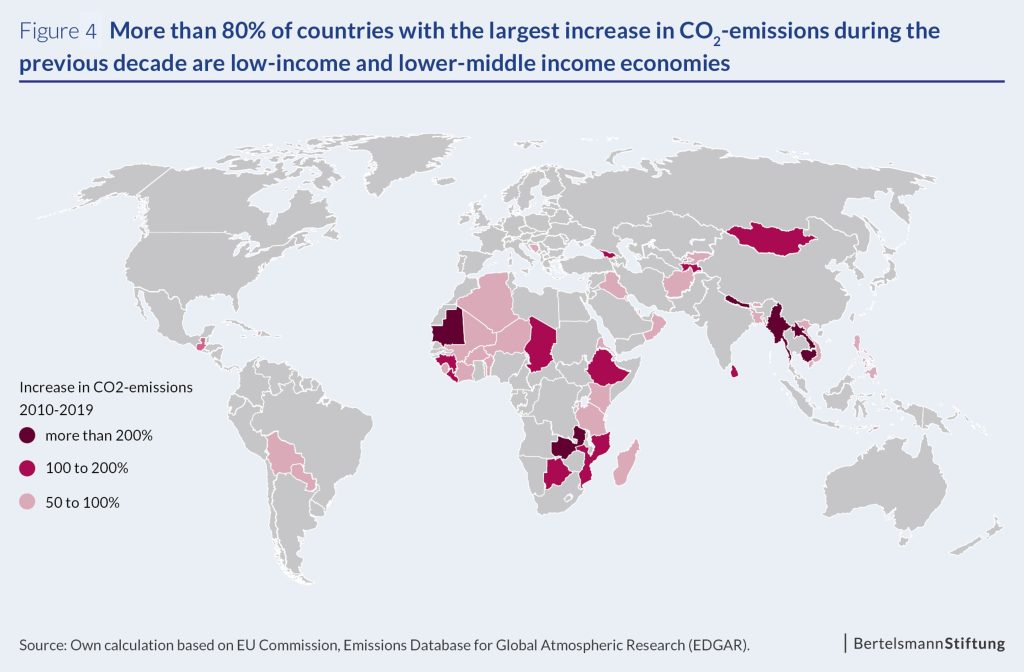
It has been repeatedly emphasized, and rightly so, that the global economic disruption triggered by the COVID-19 pandemic also represents a window of opportunity to link national declarations of commitment to green, resource-efficient, and lower-pollution post-pandemic reconstruction. However, governments in many developing and emerging countries face massive planning, social, and financial challenges, most of which they cannot solve on their own.
In terms of planning, resource efficiency, one of 14 governance indicators, is currently the third lowest-scoring indicator in the BTI. 67 out of 137 developing and emerging countries examined in the Transformation Index score a maximum of only 4 out of 10 points here, indicating a wasteful, highly deficient use of available administrative and financial resources.
In socioeconomic terms, as many as 80 of the 137 countries are characterized by massive social exclusion in the form of poverty and inequality (also 1-4 points in the BTI 2022). Understandably, both the mandate of elected democratic governments and the legitimacy to rule of autocratic regimes are accordingly based on societal expectations to improve social inclusion and economic participation opportunities. In this respect, environmental concerns are almost always (in 41 countries with 1-3 points in the BTI environmental policy indicator) or frequently (in 75 countries with 4-6 points) subordinated to growth-oriented economic policies.
Finally, in financial terms, even before the COVID-19 pandemic, many developing countries had been on the verge of insolvency. Over the past ten years, fiscal stability has deteriorated in more than half of the countries studied in the BTI, in some cases massively. As a result, the financial framework for investing in more resource-efficient and less polluting economies is severely limited in many countries.
It is therefore essential, as the head of the United Nations Development Programme (UNDP), Achim Steiner, emphasized, to advise what are now 118 countries in order to be able to implement their stated climate policy goals in a planned, financially sound, socially balanced and interministerial manner. “Climate action and development policy,” the German Ministry for Economic Cooperation and Development (BMZ) also underlined, are “bound up closely with each other.” Essential areas of development policy must be thought through in terms of climate policy, just as, conversely, emissions reduction and adaptation require a socially inclusive design of measures that is differentiated according to local conditions and reduces existing inequalities. Just as a disproportionate burden on the poorer developing countries must be avoided at the international level, taking into account the historical polluter-pays principle and current distributive injustice, climate policy measures in developing countries must be prevented from having regressive effects and burdening the poorer sections of the population.
These goals will require substantial amounts of advice, technology transfer and financing, which will have to be borne primarily by the industrialized countries. Should the industrialized countries default on climate finance, the obvious question is why a government in a developing country struggling to secure the basic needs of its people should now take responsibility and accept pollutant-reducing growth reductions when the rich and developed countries themselves are unwilling to assume a fair share of their historic and current responsibilities. To forge alliances for climate action, developed countries must accept liability. Now.
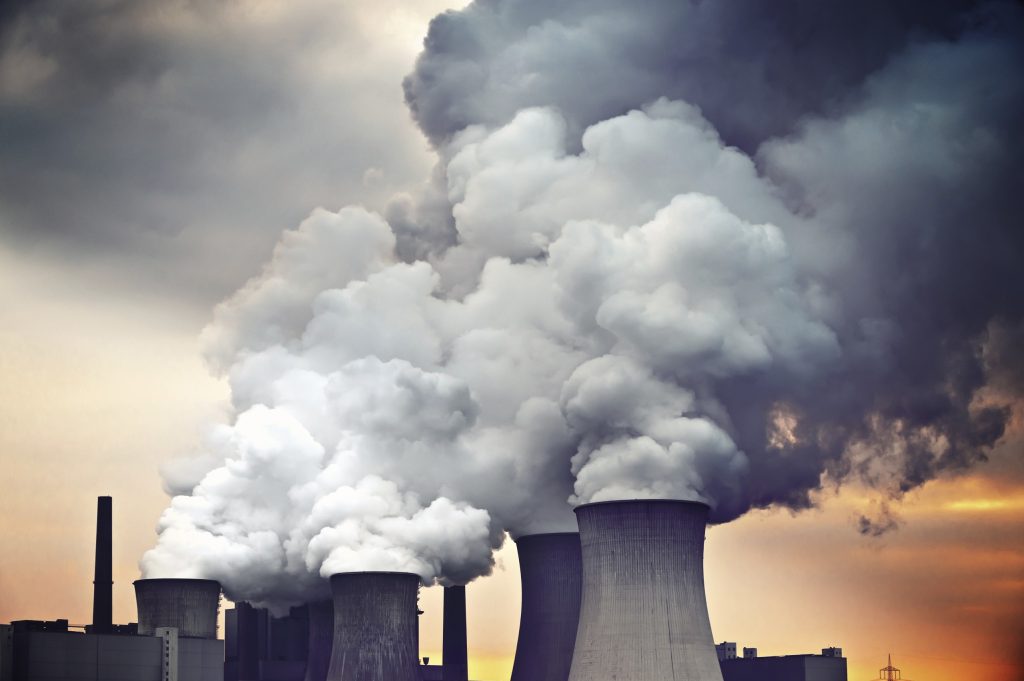



2 thoughts on “Climate Policy: Responsibilities and Liabilities”